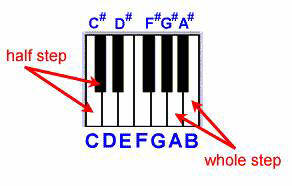|
Intervals
|
||||||||||||||||||||||
|
|
||||||||||||||||||||||
| An interval is the distance in pitch between two notes. Intervals are always measured by the number of letter names from the lower note to the higher both being included in the count. Intervals come in different qualities and size. If the notes are sounded successively, it is a melodic interval. If sounded simultaneously, then it is a harmonic interval. The smallest interval used in Western music is the half step. A visual A whole step is the distance between two consecutive white or black |
||||||||||||||||||||||
 |
||||||||||||||||||||||
| Qualities and Size Intervals can be described as Major (M), Minor (m), Perfect (P), Augmented (A), and Diminished (d). Intervals come in various sizes: Unisons, Seconds, Thirds, Fourths, Fifths, Sixths, and Sevenths. 2nds, 3rds, 6ths, and 7ths can be found as Major and Minor. Unisons, 4ths, 5ths, and Octaves are Perfect. |
||||||||||||||||||||||
 |
||||||||||||||||||||||
| When a major interval is raised by a half step, it becomes augmented. When a major interval is lowered by a half step, it becomes minor. When a major interval is lowered by two half steps, it becomes diminished. When a minor interval is raised by a half step, it becomes major. When a minor interval is raised by two half steps, it becomes augmented. When a minor interval is lowered by a half step, it becomes diminished. When a perfect interval is raised by a half step, it becomes augmented. When a perfect interval is lowered by a half step, it becomes diminished. |
||||||||||||||||||||||
| INVERSIONS OF INTERVALS Intervals can be inverted, which basically means you turn them upside down. The lower note is raised up an octave so that the top note/bottom note relationship is reversed. The chart below shows the inversions of intervals |
||||||||||||||||||||||
| Major becomes Minor Minor becomes Major Perfect remains Perfect Augmented becomes Diminished Diminished becomes Augmented |
2 becomes 7 3 becomes 6 4 becomes 5 5 becomes 4 6 becomes 3 7 becomes 2 |
|||||||||||||||||||||